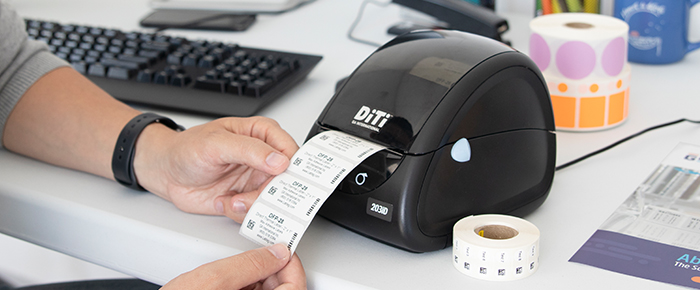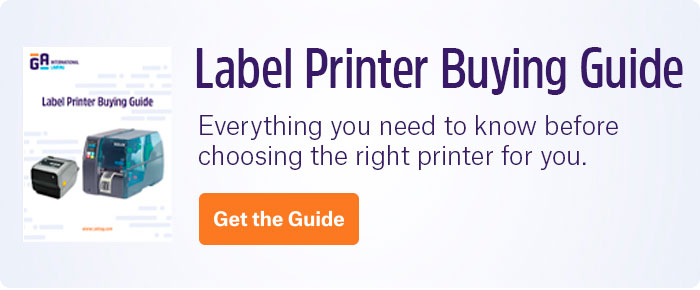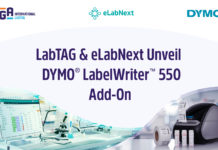
Most label printing methods require an ink source; laser printers require toner, inkjet printers require ink cartridges, and thermal-transfer printers rely on ink ribbons. Almost all of us have experienced the frustration of using one of these types of printers and running out of ink during a critical print job. Though they may not provide optimal resistance to extreme temperatures and chemical exposure, several printing methods exist that do not rely on ink cartridges or ribbons. Many of these are readily available and provide a reliable identification strategy for many of the stringent requirements lab personnel may encounter.
Direct thermal printing
These printers are much more common than you think; they’re used across retail in cash registers and many other industries, including healthcare and research. Direct thermal printers utilize a heated printhead on labels coated with a leuco dye. The leuco dye’s chemical composition results in darkening as a response to the heat of the printhead, thereby generating a detailed printout. So, while there technically is ink coating the label, the printer doesn’t require an ink cartridge or ribbon.
These printers, like our proprietary DiTi 203iD, have several advantages over conventional thermal-transfer or digital printers. They are typically much cheaper than most, with some models costing as low as 100$. Direct thermal printers can include specialized features like resistance to chemical exposure, high heat, and cryogenic storage, as well as adherence to previously frozen surfaces (though the latest DYMO models are restricted to only DYMO branded labels). Designing direct thermal labels resistant to high heat and chemical exposure is especially tricky to master, as the typical leuco dye used in most of these labels usually blackens completely when exposed to heat or harsh chemicals, like organic solvents.
Zink
Zink is another printing method that requires a special type of paper to print in lieu of ink cartridges or ribbons. Developed by Zink Holdings LLC, Zink printers are similar to direct thermal in that they are both heat-based systems. For Zink, the thermal paper is much more complex than a simple direct thermal label, which most often only yields a black color. Zink thermal paper has multiple layers composed of colorless dye microcrystals. When heated at varying temperatures and time periods, the dyes are converted to their colored form via melting and subsequent re-solidification, ultimately producing a full-color printout. There are three principal layers of the thermal paper:
- Yellow is the topmost layer, as it is sensitive to brief pulses of high heat.
- Magenta is in the middle, as it is sensitive to longer pulses of slightly lower temperature.
- Cyan is at the bottom, sensitive to relatively long pulses of lower temperatures.
These three layers are separated by thin interlayers, which act as insulation to moderate the heat throughout the paper.
NCR printing
Also called carbonless copy paper and non-carbon copy paper, No Carbon Required (NCR) paper is another type of paper coated with ink. However, instead of relying on heat, NCR paper requires pressure or impact to generate a printout. This type of paper was developed in the 50s to mark multiple documents at once.
NCR paper consists of several sheets of paper coated with micro-encapsulated dye or ink and reactive clay. The back of the top sheet is coated with micro-encapsulated dye, while the bottom sheet is coated on top with clay that reacts with the dye to form a permanent mark. Intermediate sheets are coated with clay on top and dye on the bottom. When the sheets are printed using a dot-matrix printer or written on, the micro-capsules break and release their dye, yielding an accurate picture. Although a source of ink is required to print the first layer, no external ink source is required for the second layer. Also, this technology has readily been adapted for labels where the top layer is coated with an adhesive, allowing it to be affixed onto various surfaces.
RFID
Radio-frequency identification (RFID) is a method of identification that doesn’t require a printout; instead, it utilizes microchips embedded into either tags or labels that send long-wave signals to a reader. There are many benefits of using RFID over conventional barcode labels, including the ability to scan multiple items simultaneously without a direct line-of-sight. You can also encode more information into RFID chips compared with barcodes, and they provide additional security, if needed.
RFID is also now considered just as adaptable as barcodes thanks to new technological developments. It recently became possible to generate nearly any type of label with an RFID inlay, including those resistant to chemical exposure and extreme temperatures. Also, note that this doesn’t mean RFID must be implemented exclusively; RFID labels, no matter which are used, can also be printed with barcodes on the facestock, providing an additional identification method in case there is an unforeseen issue with RFID scanning. In fact, some printers can perform both functions simultaneously, should the need arise.
LabTAG by GA International is a leading manufacturer of high-performance specialty labels and a supplier of identification solutions used in research and medical labs as well as healthcare institutions.



